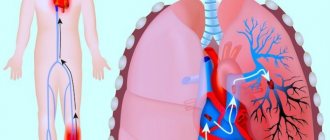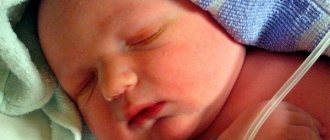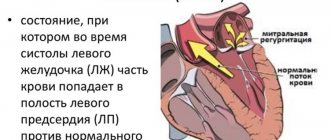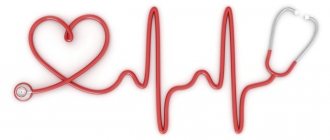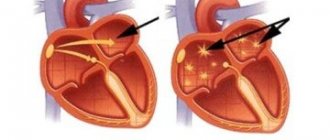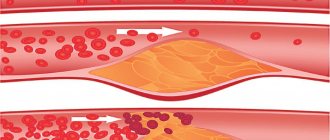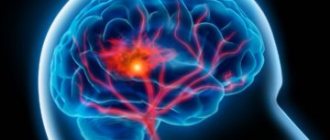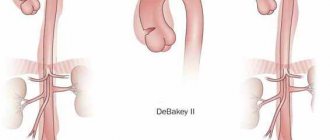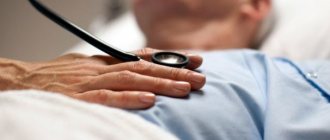Cardiovascular disease remains the most common cause of sudden death worldwide. One type of myocardial disease is dilated cardiomyopathy. It affects mainly men and is often diagnosed after death.
Correct actions regarding cardiomyopathy syndromes will help to avoid such a risk. Unfortunately, advanced disease has a very poor prognosis, with a 50% chance of death within a ten-year period.
How does the disease manifest itself?
In medicine, there is a special group of myocardial diseases called cardiomyopathy. In such diseases, the heart muscle undergoes structural and functional changes.
It most often occurs in old age, but in modern realities it affects more and more young people. First of all, it is important to understand that cardiomyopathy has nothing to do with inflammatory and tumor diseases. Its main manifestations include heart failure and arrhythmia symptoms.
Dilated cardiomyopathy, known more simply as congestive cardiomyopathy, is part of the group of primary cardiomyopathies. This means that the nature of the disease and its original cause are unclear.
In medicine, this term refers to the clinical form of cardiomyopathy. This concept includes stretching of the cavities of the heart. The second obvious sign for a professional will be left ventricular systolic dysfunction. Sometimes problems with the right ventricle are also recorded, but such cases do not occur too often. No more than ten percent of the total.
Causes and predisposing factors
Initially, the term “cardiomyopathy” was understood as a primary lesion of the myocardium of unknown etiology, which led to disruption of its functioning, but was not associated with disease of the coronary vessels, pericardium, heart valves or conduction system. Thanks to modern invasive and non-invasive diagnostic methods, the genesis of cardiomyopathies has been established. As a rule, they are caused by endomyocardial fibrosis and cardiac amyloidosis. In the etiology of such heart lesions, viral infection, autoimmune processes, and heredity are important.
It is worth noting that in almost half of the cases, idiopathic cardiomyopathy is diagnosed, the causes of which cannot be established. In addition, with many lesions of internal organs due to infections, the action of toxins, or due to metabolic disorders, specific myocardial damage is recorded, which clinically resembles cardiomyopathy.
It should be noted that the term “dilated cardiomyopathy” is used only in cases where ventricular dilatation is not associated with changes in the coronary circulation, congenital heart defects, or pericardial lesions. Dilated cardiomyopathy is sometimes associated with hypertension, β-adrenergic agonists, and alcohol consumption.
In the origin of dilated cardiomyopathy (DCM), hereditary predisposition (autosomal dominant inheritance), a combination of several etiological factors - heredity, exogenous influences and autoimmune disorders - is important.
Predisposing factors for the development of the disease are considered to be chronic alcohol intoxication, thyrotoxicosis, anemia of any origin, long-term treatment with glucocorticoids and non-steroidal anti-inflammatory drugs.
Read also Hypertension - causes, classification, symptoms, treatment, complications
At-risk groups
Dilated cardiomyopathy is not one of the well-studied diseases. Things are especially difficult when it comes to finding out the causes of the disease. There are some assumptions supported by scientific works, but the etiology itself is still being studied.
Doctors can only recommend and assume risk groups, according to statistics. However, the reasons for the appearance of symptoms still remain unclear. However, based on the number of cases and the treatment process, some conclusions can be drawn that will help reduce the likelihood of this disease occurring. In Western medicine, it is customary to identify five causes of dilated cardiomyopathy:
- hereditary;
- toxic;
- metabolic;
- autoimmune;
- viral.
Unfortunately, in thirty percent of cases the disease is inherited. In general, every third patient with a similar disease has one of his closest relatives with the same diagnosis.
The toxic cause is much more prosaic - alcohol. Increased doses of ethanol provoke damage to contractile proteins and disrupt the necessary level of metabolism. However, not only alcohol is included in this group. Toxic lesions also include occupational diseases. People in contact with industrial dust, metals and harmful substances are also in the second risk group.
Elementary malnutrition, protein deficiency, and lack of basic vitamins also provoke the risk of disease. However, such manifestations are possible only with a very long incorrect lifestyle. This is very rare in medical cases.
For example, a person for about ten years had problems with proper nutrition and sleep patterns, as a result of which he experienced a malfunction that resulted in the development of dilated cardiomyopathy, but such cases account for less than 5 percent of all patients. Moreover, they usually enter for treatment of dilated cardiomyopathy, having also an accompanying bouquet of various diseases, not only heart diseases.
Vivid and minor symptoms of heart disease
The insidiousness of this type of heart disease is that more than half of the patients have no complaints about deteriorating health. In this case, only an annual medical examination can help. However, without pain in the heart area, few people voluntarily go for in-depth studies of the heart muscle.
Chest pain is a sign of illness
First of all, the following symptoms should alert you:
- fast fatiguability;
- dry cough without signs of acute respiratory viral infection;
- attacks of suffocation;
- Characteristic pain in the chest.
Less than ten percent of patients report particular pain in the right hypochondrium. In part, it resembles signs of appendicitis or acute poisoning. Severe swelling of the legs is possible. If any of the above symptoms occur, you should immediately consult a doctor. It is far from a fact that the diagnosis will indicate dilated cardiomyopathy, but in any case, such health problems will not haunt a completely healthy person, which means that you need to start monitoring the body.
Pay special attention to your condition at night. With cardiomyopathy, the body suffers mainly during sleep. Attacks of cardiac asthma are quite possible. In addition, a dry cough will occur when lying down. The same applies to pronounced suffocation.
Swelling of the legs appears only at night, and tends to subside in the morning. Pain in the right hypochondrium occurs due to stretching of the liver capsule.
Heart symptoms
Problems with the heart muscle are usually classified as a separate group of symptoms. According to statistics, 90% of patients have various heart problems. Over time, they will become more pronounced, causing the risk of sudden death.
In most cases, atrial fibrillation is recorded. There is a risk of developing other arrhythmias. For example, ventricular, since the disease directly affects the left ventricle.
Symptoms of the disease in advanced cases
If at the first stage of the disease it is difficult to diagnose it, then in advanced cases, unfortunately, only very irresponsible people ignore pronounced symptoms. Here we are often talking about urgent help, without which a person can die at any moment. The prognosis will be very unfavorable. Of course, dilated cardiomyopathy does not have to be fatal, but the risk is very high.
A patient with an advanced disease can no longer live a normal life. He is constantly bothered by various pains. In particular, he cannot sleep because he is out of breath and often tries to fall asleep in a sitting position. Due to stagnation of blood in the lungs, the patient's breathing is noisy and with pronounced wheezing. Edema not only affects the limbs, but gradually spreads to the entire body.
Often such patients have constant shortness of breath and discomfort from any sudden movements. It is necessary to urgently consult a doctor, since, in addition to sudden death, disability and a very difficult rehabilitation period are possible. In some cases, the ability to care for oneself is completely lost and the patient becomes dependent on others without leaving the bed.
Patient care
Diagnostics
The diagnosis is made after examination, history taking, based on tests and instrumental methods. They conduct an initial examination, ask the patient about his health and prescribe tests at the clinic, where they often do a cardiogram and ultrasound. More complex diagnostic procedures on the heart are performed in a diagnostic center or cardiology department of a hospital. Only after this the doctor prescribes treatment.
Physical examination data of patients with DCM are not specific, that is, they can indicate not only this disease, but also other health disorders. With dilated cardiomyopathy, the doctor's attention will be drawn to:
- cyanosis (blue skin);
- swelling in the legs;
- swollen neck veins;
- hepatomegaly (increase in liver size).
By tapping the patient's chest, that is, performing percussion, one can determine the enlarged size of the heart. When listening to heart sounds (auscultation), heart murmurs are detected - they arise due to the fact that the heart valves are not able to prevent the reverse flow of blood through the dilated atrioventricular openings. Moist rales are often detected in the lungs.
Analyzes
Laboratory diagnostics makes it possible to determine which diseases provoked the pathology. It is also important for monitoring the effectiveness of the treatment.
- Blood and urine analysis. In case of secondary dilated cardiomyopathy, tests will show changes characteristic of the underlying disease (low hemoglobin levels in alcoholism, protein in the urine in autoimmune diseases, etc.).
- Blood chemistry. The study determines the level of cholesterol, glucose, creatinine and uric acid (indicators of kidney function) to diagnose associated pathologies. Elevated liver enzymes indicate blood stagnation in the liver.
- Expanded coagulogram. It is carried out not only to determine blood clotting, but also to promptly detect the appearance of blood clot breakdown products in the patient’s blood. There should be no blood clots or residues of their products normally.
An immunological blood test is also performed (for the presence of antibodies to microbes, and in autoimmune diseases - to one’s own cells) and for C-reactive protein. The level of this protein in the blood increases with any inflammation. In familial cases of the disease, genetic diagnosis may be required.
Instrumental diagnostics
Instrumental studies show the degree of expansion of the heart cavity, the condition of the heart muscle and blood vessels, and can exclude congenital heart and valve defects, tumors. There are invasive and non-invasive methods for examining patients with dilated cardiomyopathy.
- Non-invasive, that is, without intervention in the body, include ECG, EchoCG, and chest x-ray. If necessary, the doctor may prescribe other examinations: MRI or computed spiral tomography of the heart: ECG (electrocardiography) and SMECG (24-hour electrocardiogram monitoring) evaluate the frequency and severity of heart rhythm disturbances, monitor the effectiveness of treatment of arrhythmias.
- EchoCG (echocardiography, ultrasound examination of the heart) shows the size of its cavities, the thickness of the myocardium, congenital and acquired defects. Thus, with dilated cardiomyopathy, all chambers of the heart are enlarged, the thickness of the walls of the organ is normal or reduced, and the contractility of the left ventricle is reduced. Doppler echocardiography visualizes the speed of blood flow in the coronary vessels and through the heart valves.
- Chest X-rays are done for those patients for whom other methods are of little information, for example, people with obesity. The x-ray clearly shows the enlargement of the heart - it becomes “spherical”.
- Coronary angiography and ventriculography (in combination or separately) are x-rays of the heart and coronary arteries with contrast. Examinations are recommended if the cause of DCM is suspected to be CAD.
In patients with DCM, the test is stopped due to fatigue and shortness of breath. With coronary heart disease, it is difficult for a person to perform physical exercise due to the so-called decrease in coronary reserve. This means that their heart, as the load increases, cannot increase blood flow adequately to the increased demands of the heart muscle, resulting in chest pain and/or specific changes on the ECG.
Complications of the disease
The worst risk is sudden death from heart failure. Other complications include:
- cardiac rhythm and conduction disturbances;
- blood clots in the heart area;
- ventricular tachycardia;
- ischemic stroke.
Lack of treatment is a sure path to death. If the symptoms of the disease are ignored, the patient gradually develops blood clots in the heart area. Over time, platelets clog large arteries and cause ischemic stroke.
In the case of ventricular tachycardia, sudden ventricular fibrillation is possible. Without the necessary medical care, a person is at risk of sudden cardiac arrest.
Without treatment, the heart will exhaust its resource very quickly compared to a healthy person. Within a short period of time, dystrophy of all vital organs occurs.
Diagnosis of dilated cardiomyopathy
Examination data can only reveal signs of diseases against which cardiomyopathy occurred. On auscultation, 1 tone is weakened, accent is 2 tones; if the left ventricle is overloaded, there may be a gallop rhythm.
Instrumental diagnostic data:
- ECG – low voltage, left ventricular hypertrophy, arrhythmia, tachycardia, fibrillation.
- X-ray – the heart is enlarged in all directions, pulmonary congestion.
X-ray for DCM
- EchoCG is the main diagnostic method. The size of the heart chambers is increased, the amplitude of contraction of the walls is reduced, relative insufficiency of the heart valves, blood clots near the walls.
- Exercise tests - differential diagnosis with ischemic heart disease is carried out; with cardiomyopathy, shortness of breath occurs, and with ischemic heart disease, pain occurs.
- MRI – disturbances in myocardial contraction, late filling with contrast.
- Coronary angiography – cardiac output is reduced, signs of pulmonary hypertension.
- Biopsy - myocardial cells are increased in size, fibrous changes.
The study of neurohormones helps to establish a diagnosis and assess the severity of the disease. Natriuretic protein, interleukin-6 and norepinephrine are determined.
For information about what EchoCG shows in DCM, watch this video:
Treatment of cardiac disease
It is very important to consult a doctor at an early stage of the disease, when diagnosis is possible based on primary symptoms. In this case, the prognosis will not immediately become favorable, but the health risk will be significantly reduced. In fact, the patient will increase his chances of fighting a disease that is difficult to treat with standard treatment.
Basic pre-treatment restrictions for patients with dilated cardiomyopathy include:
- exclusion of physical activity;
- a complete ban on the consumption of table salt;
- Bed rest is advisable depending on the course of the disease.
Drug therapy is considered effective. According to statistics, 80% of patients can receive drugs that have a positive effect on the course of the disease.
List of most commonly used medications:
- Cantopril;
- Perindopril;
- Enalapril.
The three above drugs are included in the group of inhibitors. For pronounced heart rhythm disturbances, special adrenergic blocking drugs are used. The most popular remedy is Bisoprolol. It is possible that the doctor will also prescribe medications aimed at reducing blood flow to the area of the right side of the heart muscle.
Each disease is individual, so it is very important not to self-medicate in such a difficult situation. Most often, doctors prescribe a specific treatment for DCM (dilated cardiomyopathy), based on the individual characteristics of the body. In most cases, additional medications are prescribed to thin the blood. In particular, simple aspirin or Acecardol.
To get rid of the symptoms of shortness of breath during an uncomplicated course of the disease, doctors recommend special nitrates in the form of a spray. Often such patients are helped out by the drug Nitromin, sold in pharmacies in the form of an aerosol.
Symptoms of dilated cardiomyopathy
Symptoms at the initial stage are not specific only to this pathology, so patients may not see a doctor for a long time or be treated for another disease. Most often, patients complain about:
- difficulty breathing during exercise and then at rest;
- weakness and fatigue;
- rapid pulse;
- swelling in the legs;
- heaviness on the right in the hypochondrium and epigastric region.
Pain in the heart occurs from overstretching of the cavities of the heart, so they are usually weak and short-lived, which leads to a late diagnosis. In the advanced clinical stage, when the compensatory capabilities of the myocardium are exhausted, signs of cardiac failure appear. A characteristic feature is the rapid increase in symptoms and complications in the form of:
- insufficiency of cardiac output, first of the left and then of the right ventricle;
- congestion in the pulmonary and systemic circulation;
- arrhythmias, fibrillation, impaired conduction (blockade);
- thromboembolism.
Surgical intervention
If standard methods fail to progress the disease, secondary dilated cardiomyopathy occurs and the threat to life continues to exist, then surgical intervention is prescribed. The decision to undergo heart surgery is usually made not by a single doctor, but by a special council consisting of the best specialists who take responsibility for the patient’s life. There are three types of surgical intervention for this disease:
- implantation of a defibrillator into the heart;
- removal of excess tissue in the left ventricle;
- heart transplantation.
Heart transplant surgery
Doctors will try to avoid surgery until the last minute, but the decision in any case will be made depending on the risk ratio between surgery and sudden death. That is, in cases where the disease threatens death in a short time, surgery remains the only hope to prolong life, although it may be the last for the patient.
Implantation of a defibrillator is necessary when life-threatening arrhythmia symptoms occur. If everything goes well, after surgery the patient’s heart will function normally. If the operation is performed correctly and no complications occur, then the ten-year survival rate in uncomplicated patients increases significantly.
Implantation of a pacemaker is prescribed in cases of intraventricular conduction disturbance. In addition, it is possible to implement this method of treatment when synchronous contractions in the atria and ventricles are separated. The operation helps to get rid of such symptoms, but the risks are quite high.
Removal of excess tissue in the left ventricle is called myotomy in medical terminology. The point is that part of the tissue interferes with the outflow of blood. After surgery, this problem disappears, reducing the risk of cardiac arrest.
Treatment
If the direct cause of the disease cannot be identified (idiopathic dilated cardiomyopathy), patients are treated symptomatically. It is aimed at correcting heart failure, against arrhythmia and at preventing thromboembolism. In this case, the patient needs:
- Limiting physical activity. In severe cases of dilated cardiomyopathy, strict bed rest is prescribed for several weeks or a month. At the beginning of the disease, after examination and under the supervision of a doctor, dosed physical activity is recommended.
- A diet high in animal protein; with restriction of salt (< 3 g per day) and liquid (< 1.0–1.5 l per day). Alcoholic drinks are strictly prohibited.
Treatment for a diagnosis of “secondary dilated cardiomyopathy” is complex. This is an effect on the underlying disease (autoimmune, endocrine), as well as therapy for heart failure and its complications.
Conservative therapy
The main group of drugs used to treat patients with dilated cardiomyopathy, especially its familial form, are beta blockers (Carvedilol, Bisoprolol, etc.). They help lower blood pressure, normalize heart rate, and have an antiarrhythmic effect. Treatment begins only after the patient’s heart failure has been compensated with other drugs, with a minimum therapeutic dose. The dose is increased very slowly and gradually brought to the maximum tolerated dose.
In case of heart failure of any origin, to combat stagnation of blood in the lungs, in the systemic circulation, patients are necessarily prescribed diuretics - thiazide, thiazide-like and loop. For significant edema, these diuretics are combined with aldosterone antagonists (Aldactone®, Veroshpiron and Veroshpilactone®). They also have a diuretic effect and prevent the body from losing potassium, a trace element important for the normal functioning of the heart muscle.
Patients with heart failure are also prescribed other medications. Some of them normalize blood pressure and help remove excess fluid from tissues. The action of others is aimed at regulating heart rhythm and preventing complications of heart failure.
- ACE inhibitors - Elanapril, Ramipril, Peridopril (Prestarium®), Co-Perineva® (perindopril + diuretic indapamide). They lower blood pressure, improve blood circulation, and increase stress tolerance of the heart muscle. The drugs are taken for a long time and are recommended for all patients with heart failure.
- Angiotensin II receptor antagonists - Vitopril (Lisinopril), Losartan, Lorista®, (losartan + diuretic hydrochlorothiazide). They act with ACE inhibitors and protect the heart muscle and vascular walls from adverse effects. They are prescribed to people with intolerance to the above drugs, and in severe (decompensated) forms of heart failure - in combination with them.
- Cardiac glycosides (Digoxin, Celanide®, Strophanthin, Korglikon) are prescribed for some arrhythmias. They increase the performance of the heart muscle and normalize its contractility, reduce shortness of breath and other manifestations of congestion in the lungs.
- Antiplatelet agents and indirect anticoagulants - Aspirin, Heparin. They are prescribed for arrhythmias, high risk of blood clotting disorders and thromboembolism.
However, sooner or later there comes a time when conservative therapy stops working. And then comes the turn of surgical treatment - operations to correct cardiac functions or heart transplantation.
Surgical treatment and electrophysiological methods
Dilated cardiomyopathy is an irreversible change in the heart muscle, and until recently the only 100% effective way to return a patient to a normal quality of life was a heart transplant. However, today other types of surgical interventions have been mastered:
- Implantation of a pacemaker (two- and three-chamber electrical stimulation of the heart).
- Dynamic cardiomyoplasty. The operation consists of wrapping a heart affected by DCM with a portion of the patient's back muscle. It improves exercise tolerance, reduces the need for medications, improves treatment results, but slightly increases life expectancy.
- Implantation of an extracardiac mesh frame made of several layers of synthetic twisted threads: it is fixed at the border of the atria and ventricles of the heart. The volume of the artificial mesh when maximally stretched does not exceed the maximum volume of the heart during relaxation. It is very elastic, and therefore, over time, the volumes of the ventricles decrease slightly, and the “pumping” function of the heart improves.
- Valve replacement.
- Implantation of circulatory assist devices: pumps implanted into the apex of the left ventricle, which pump blood into the aorta. This operation is much more expensive than the previous ones and has a high risk of thrombosis, thromboembolism, and infectious complications.
Heart transplantation is considered the procedure of choice for patients with end-stage heart failure. The main criterion for determining indications for heart transplantation is that the prognosis of survival of the patient without a transplant within a year without transplantation is below 50%.
Experimental methods
One of the innovative ways to treat pathological changes in the structure of the heart muscle is stem cell therapy, usually taken from the patient’s own bone marrow. Cell therapy is based on the ability of stem cells to transform into cells of any body tissue upon physical contact with them, promoting tissue regeneration. In this case, these are heart cells, or cardiomyoblasts.
After injection into the myocardium, stem cells and cardiomyoblasts replace cells of scar (connective) tissue that interfere with the functioning of the heart muscle. Thanks to the improvement of muscle tissue, the contractility of the heart increases, its performance is normalized, and the condition of the coronary arteries and other vessels improves. Accordingly, the patient’s swelling disappears and the functions of other internal organs improve: liver and kidneys, lungs.
Currently, the method of stem cell therapy for myocardial diseases has not been sufficiently studied. Therefore, such treatment is carried out in few clinics as clinical trials.
Heart transplant
Statistics say that the ten-year survival rate for heart transplantation averages over seventy percent. This is the most extreme way to solve the problem. Not many people, even in a critical situation, decide to undergo such an operation, and financially it is very expensive.
Doctors recommend such radical measures only in the most advanced cases, when other operations are no longer possible, and the patient’s life can actually be interrupted at any moment.
The patient's own heart can be completely removed during such an intervention. The heart is replaced with a donor one. It is important to understand that for modern doctors, heart transplantation is a routine job. The average survival rate of patients without complications is just over ten years. There is even a kind of world record. In the USA, a patient lived for more than thirty years with a transplanted heart and died not from heart failure, but became a victim of skin cancer.
Dilated cardiomyopathy holds the lead among diseases for which emergency heart transplantation is used. In more than 50% of cases, vital organ transplantation is performed precisely for this disease.
There are a number of contraindications for this operation. In individual cases, exceptions are possible, but usually doctors do not risk resorting to surgical intervention when it comes to patients:
- over 65 years old;
- with active infection;
- having a malignant formation;
- alcohol and smoking abusers;
- with a survival prognosis of less than three years.
In the above cases, heart transplantation is contraindicated in most medical institutions. However, many cases are resolved individually. Some doctors are willing to take the risk for the patient's life if the patient takes full responsibility for his or her health during and after surgery.
Mechanism of development of dilated cardiomyopathy
Under the influence of damaging factors, the following changes occur in the activity of the heart:
- the number of healthy myocardial cells decreases;
- the chambers of the heart expand;
- at the initial stage, the rule applies - the more the wall stretches, the more it contracts;
- heart rate increases.
These manifestations relate to the period of compensation. Then the reserves are depleted, the ejection of blood from the heart decreases, the cavities expand even more, and because of this, relative valve insufficiency develops. In order to cope with such hemodynamics, the walls begin to thicken - the heart becomes much heavier than normal. Stagnant processes develop in the pulmonary and systemic circulation.
Low blood flow to the kidneys activates the sympathetic system and the production of vasoconstrictor substances - catecholamines, aldosterone. The result is a rapid pulse, arrhythmia, vasospasm, sodium and fluid retention in the tissues. For the heart, these conditions make it even more difficult for the heart to function.
Due to impaired blood flow, blood clots form inside the cavities. This is also facilitated by the disturbed rhythm of contractions and low anticoagulant activity of the blood. Therefore, thromboembolism is one of the common complications of this disease.
Lifestyle for patients with cardiomyopathy
When the doctor makes an official diagnosis, then, first of all, the patient will be required to completely change his usual lifestyle. Of course, sometimes it happens that a person already fully complies with it, but often habits will need to be changed radically. The following measures must be taken to successfully combat the disease:
- completely give up bad habits (smoking, alcohol, drugs);
- reduce excess weight;
- establish proper nutrition;
- limit sweets and foods not recommended for consumption in the diet;
- limit salt;
- the operating mode should not exhaust the body;
- excessive physical activity is contraindicated;
- a psychological attitude is needed to win the fight against the disease.
Proper nutrition is the key to health
Proper nutrition in most cases involves small portions, but often. Doctors usually recommend eating six times a day with a similar diagnosis. Each case requires an individual diet, but general recommendations are still present.
In particular, patients are advised to have in their diet as much food as possible enriched with omega-3 unsaturated fatty acids. Mainly found in fish:
- salmon;
- trout;
- caviar.
In addition, foods rich in selenium and zinc will be beneficial. Here, doctors will most likely advise adding cereal, buckwheat, eggs, lard and porcini mushrooms to the diet.
Limiting salt intake is aimed primarily at combating edema. The same goes for drinking fluids. The standard limit for a person with a similar disease is no more than one and a half liters of water per day, even in hot weather.
Pay attention to the operating mode. In general, it is recommended to carry out work activities within the framework of a shortened working day. If this is not possible, then it is not allowed to disrupt sleep and rest patterns. With cardiomyopathy of any kind, it is important to sleep at night, otherwise all efforts to combat the disease will go down the drain.
The psychological attitude is especially important to combat dilated cardiomyopathy. It is important to understand that any of the most successful treatment tactics for a disease will not bring the desired result if a person does not believe in a positive outcome. Survival statistics, of course, are not the most favorable, but at the same time there are a lot of people with a similar diagnosis all over the world who lead a decent lifestyle at any age.
Preventive measures
It cannot be said that there is a special method that can reduce the likelihood of developing dilated cardiomyopathy to zero. If there is a genetic predisposition in the family, then, of course, it is necessary to undergo an annual cardiac examination.
Often, those who have had cases of the disease among their relatives are advised to give up professional sports and are not advised to choose a profession where they will have to deal with increased physical stress on the body.
The most basic preventive measures, like any other disease, are no different in the case of cardiomyopathies of all types. It is necessary to completely abandon bad habits, follow a sleep and rest schedule, and receive a healthy and balanced diet.
With the achievements of modern medicine, dilated cardiomyopathy is not a death sentence. Of course, this is a very unpleasant diagnosis, but timely treatment of the disease can significantly reduce the risk of sudden death. The main thing is to seek medical help at the first unpleasant symptoms of the heart. Otherwise, when the disease begins to develop and enters an advanced stage, there is a high risk of ending up on the operating table.
However, even in the most terrible scenarios, it is possible to prolong life through competent surgical intervention. The five-year survival rate for patients diagnosed with dilated cardiomyopathy averages 80 percent. If you follow all the instructions of a qualified attending physician, lead a correct lifestyle and have the necessary psychological attitude, then it is quite possible to maintain a decent quality of life.

